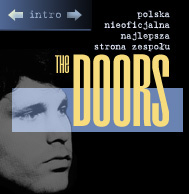|
Article
by Pat H. Broeske 1990
Morrison Mystique
In his 1967 Elecktra Records publicity bio, Jim Morrison wrote,
"I've always been attracted to ideas that were about revolt
against authority. I like ideas about the breaking away or over-
throwing of established order. I am interested in anything about
revolt, disorder, chaos- especially activity that seems to have
no meaning. It seems to me to be the road toward freedom..."
In the same bio, Morrison said that his favorite color was tur-
quoise, that what he looked for in a girl were "hair, eyes,
voice, walk" and that all his family members were dead.
But, they really weren't. Morrison was creating his own myth.
It was a myth that he perpetuated with his near-mystic, highly
sensual stage presence. He once dubbed himself "The King of
Orgasmic Rock," with some justification. He was both pretty
and handsome, slim yet charged with strength and energy, and
capable of projecting a sense of danger- of the demonic. It
was a combination along with his talent for writing poetic lyrics,
that seemed to appeal to males and females alike, for all kinds
of reasons, tapping a range of fantasies.
Morrison liked to relate how, as a child, he was driving with his
parents across the desert when they came upon an overturned
truck and some dead Indians in the road. At that point, claimed
Morrison, he became possessed by the spirit of one of the Indians.
Thus, he often wore a concho belt, along with his leather pants,
and let loose with ritualistic-type dance movements on stage.
Of one thing there was no doubt; Morrison was possessed by
personal demons. Those demons, and his artistic search, led
to his drug use and, finally, to raging alcoholism. As a result of
his excesses, Morrison got into brawls, was arrested, showed
up late for concerts and passed out on stage in Amsterdam. He
also changed physically; less than three years after he'd shot
to the top, the hell-child with the lean, brooding good looks was
fat and full-bearded.
Those who knew him would later surmise that Morrison the poet
was struggling to break free of the mythic rock star figure he'd
created.
The son of a Navy rear admiral, Morrison was born James Douglas
Morrison on December 8th, 1943, in Melbourne, Florida.
A voracious reader, Morrison, whom many have described as
"brilliant" and "a genius," spent two years at a junior college
in St. Petersburg, Fla. He then made his way to UCLA, where
he studied film, wrote poetry, ingested lots of drugs, and after
graduation, took to living on the beach at Venice.
It was there that Morrison bumped into a fellow film school
graduate, Ray Manzarek. "I hadn't seen Jim all summer. He'd
lost about thirty pounds. I remember thinking how incredibly
handsome he looked," recalled Manzarek. But what really
startled Manzarek was when Morrison sang for him the lyrics
to a song he'd written called "Moonlight Drive."
Manzarek and Morrison formed a group, bringing in guitarist
Robby Drieger and drummer John Densmore, both of whom
Manzarek had met at a meditation center. Morrison came up
with the group's name, which comes from a William Blake
passage.
From the beginning, the college-educated Doors stood out as
a group of innovation and eerie magnetism with their mix of
music, poetry, theatre and daring. The Doors' hits, including
"Light My Fire," "People Are Strange," Touch Me" and "Riders
On The Storm," remain benchmarks of the era. So does Mor-
rison's behavior.
One night at the Whisky, the entire club, including the go-go
girls, came to a shocked stand-still during his improvised ren-
dition of the song "The End." An Oedipal journey, it climaxes
with a young man's screaming threat to kill his father and rape
his mother. But rape wasn't the word that Morrison used. The
Doors were fired from the club that very night after the enraged
Whiskey owner screamed at Morrison for being "one foul-
mouthed son-of-a-bitch."
It was Morrison's behavior at the now-infamous Miami concert
in March 1969, that symbolized his downfall. After taunting the
crowd with obscenities, he threatened to expose himself. Mor-
rison, who wasn't wearing underwear, went on to tug at his
pants. Days later, in the heat of a conservative political move-
ment sweeping the city, he was arrested on charges including
indecent exposure.
Miami marked a turning point for the Doors, internally. It didn't
help that Miami had been the first stop on a 21-day tour, and
that after Morrison's arrest the other 20 cities cancelled .
Though they went on to record additional albums, and enjoy
success on the charts, the symbiosis was waning. After record-
ing the group's "L.A.Woman," a burned-out Morrison headed
to Paris to concentrate on his poetry.
To hear the three surviving Doors tell it, he would eventually
have returned to the fold, especially after the startlingly good
reviews for "L.A.Woman."
We'll never know. Morrison was just 27 when he died on
July 3, 1971, reportedly of a heart attack, which he suffered
in the bathtub.
He's buried in Pere La Chaise Cemetery, along with Edith Piaf,
Oscar Wilde, Balzac, Chopin and other notables.
But Morrison and the Doors live on. Their music has been
featured on at least ten movie soundtracks in the past decade.
Their songs are also re-recorded by contemporary artists. The
Doors' record sales in this country alone today exceed 1 mil-
lion copies annually. New repackagings are constantly in the
works, as are new videos.
Plus Morrison's poetry, first printed in the 1970's, is enjoying
new attention. There are even efforts underway, by Morrison
associates and devotees, to get his poetry included in college
curriculums.
Los Angeles Times Calendar
January 7, 1990
|
